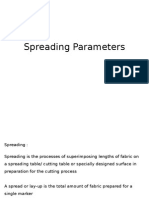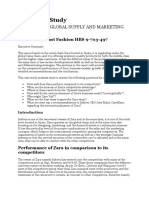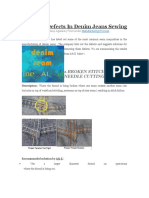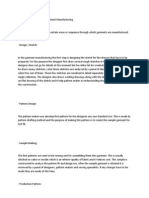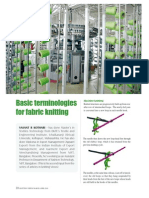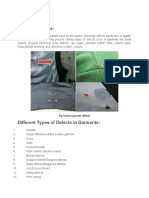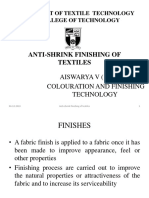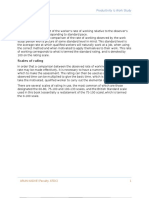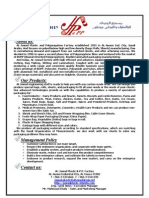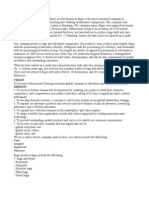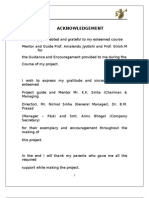0 ratings0% found this document useful (0 votes)
641 viewsManual Spreading
Manual Spreading
Uploaded by
arunkadveSpreading is the process of laying out fabric in preparation for cutting. Multiple plies or layers of fabric are aligned and placed on a spreading table. Spreading can be done manually or with computer-controlled machines. The key objectives of spreading are to correctly align the plies based on the marker plan length and width, cut multiple plies simultaneously to reduce costs and increase efficiency, and ensure each ply is flat, tension-free and free of defects. Factors like ply alignment, tension, flatness, and direction must be considered to produce an accurate spread.
Copyright:
© All Rights Reserved
Available Formats
Download as DOCX, PDF, TXT or read online from Scribd
Manual Spreading
Manual Spreading
Uploaded by
arunkadve0 ratings0% found this document useful (0 votes)
641 views4 pagesSpreading is the process of laying out fabric in preparation for cutting. Multiple plies or layers of fabric are aligned and placed on a spreading table. Spreading can be done manually or with computer-controlled machines. The key objectives of spreading are to correctly align the plies based on the marker plan length and width, cut multiple plies simultaneously to reduce costs and increase efficiency, and ensure each ply is flat, tension-free and free of defects. Factors like ply alignment, tension, flatness, and direction must be considered to produce an accurate spread.
Original Description:
Spreading & its mode
Original Title
Spreading
Copyright
© © All Rights Reserved
Available Formats
DOCX, PDF, TXT or read online from Scribd
Share this document
Did you find this document useful?
Is this content inappropriate?
Spreading is the process of laying out fabric in preparation for cutting. Multiple plies or layers of fabric are aligned and placed on a spreading table. Spreading can be done manually or with computer-controlled machines. The key objectives of spreading are to correctly align the plies based on the marker plan length and width, cut multiple plies simultaneously to reduce costs and increase efficiency, and ensure each ply is flat, tension-free and free of defects. Factors like ply alignment, tension, flatness, and direction must be considered to produce an accurate spread.
Copyright:
© All Rights Reserved
Available Formats
Download as DOCX, PDF, TXT or read online from Scribd
Download as docx, pdf, or txt
0 ratings0% found this document useful (0 votes)
641 views4 pagesManual Spreading
Manual Spreading
Uploaded by
arunkadveSpreading is the process of laying out fabric in preparation for cutting. Multiple plies or layers of fabric are aligned and placed on a spreading table. Spreading can be done manually or with computer-controlled machines. The key objectives of spreading are to correctly align the plies based on the marker plan length and width, cut multiple plies simultaneously to reduce costs and increase efficiency, and ensure each ply is flat, tension-free and free of defects. Factors like ply alignment, tension, flatness, and direction must be considered to produce an accurate spread.
Copyright:
© All Rights Reserved
Available Formats
Download as DOCX, PDF, TXT or read online from Scribd
Download as docx, pdf, or txt
You are on page 1of 4
Spreading
Spreading is the process of superimposing lengths of fabric on a
spreading table of garments, cutting table, or specially designed surface
in preparation for the cutting process. A spread or lay-up is the total
amount of fabric prepared for a single marker. A spreading may consist of
a single or multiple plies. The height of a lay-up or spreading is limited by
fabric characteristics size of the order to be cut, cutting method, and the
vertical capacity of the spreader. The number off plies in a spread may
range from 1 to 300.
Spreading may be done manually or
by computer-controlled machines.
One person or two, depending on the
width and type of fabric, type of
equipment, and size of spread, may
be involved with the spreading
process. Two people may be used for
manual spreading unless the spread is
very short. One person may work
each side of the table in order to keep
the fabric flat, smooth, and tensionfree. With automatic spreading, the
equipment controls the tension, fabric
placement, and rate of travel. The
spreading operator monitors the
process and removes fabric flaws as
needed.
Manual spreading
Computer-controlled spreading
Types of spreading:
Flat Spreads - All plies are of the same length.
Stepped Spreads - this as the name suggests, is built up in steps,
with all the plies in one step having the same length. A stepped
spread is generally used when the quantities to be cut precludes
the use of a flat spread. The cut order plan details the colours and
ply lengths for a stepped spread, if it is needed.
Objects of Fabric Spreading:
1. To place the number of fabric plies to the length of the marker plan
correctly aligned as to the length and width.
2. To cut garments in large scale and saving fabric through the use of
multi garments marker plan and the saving in cutting time per
garment that result from cutting many piles at the same time.
3. To make every ply flat and plane.
4. At correct tension.
Factors of Fabric Spreading:
1. Alignment of the fabric plies: Fabric plies should be aligned
according to the marker length and marker width.
2. Correct ply tension: To prepare the lay of the fabric, during fabric
spreading its base condition to maintain the correct ply tension.
3. Fabric must be flat: During fabric spreading it should be carefully
noticed that there is no and fold or crinkle in the fabric.
4. Elimination of fabric fault: The fold of fabric must be indicated
during spreading and necessary steps should be taken to remove
these faults. It is the duty of the operator.
5. Correct ply direction: During fabric spreading it is very important
to detect what type of fabric it is and spread the fabric with correct
ply direction.
6. Elimination of static electricity: In fabric spreading static charge
may produced due to friction specially the fabric containing the
man-made fiber like polyester, nylon etc. To overcome the problem
we should take following steps:
i.
ii.
To use the antifriction paper,
To increase the moisture of
cutting room,
iii.
To use silicon finish in cutting
blade.
7. To avoid the fusion between fabric layer: In case of cutting of
fabric lay by cutting knife, friction may be produced between lay
and cutting knife which contains thermo plastic fibers may fused
due to heat generation. To avoid these problem previous steps
should be taken.
8. Matching check and stripe: During fabric spreading it should be
carefully noticed that checked and stripe should be matched
otherwise garments may be fault.
9. Easy separation of the cut lay into bundles: Identification
marks are used in plies due to colour or shade variation.
Before spreading some parameters must be keep in
mind:
1. Mark the Splice Zone on the Spreading Table
2. Use Paper for the first ply in case the table surface is rough or when
fine fabrics are being spread
3. Identify the defects noticed in the fabric by means of sticker
4. Use lubricated paper for separating layer
5. To prevent scorching in the natural fibers (coarse fabrics).
6. To prevent fusing in the synthetic fabrics.
7. Ensure that decided number of ply count and height of the spread is
achieved.
How to spread:
Pull the fabric to far end position
Position the fabric at the far end (with our without weight or pins)
Align the ply (width on one side
Cut the ply after each la
Repeat this process from until the entire roll is spread
Check ply count
Techniques for Spreading Quality:
Removing Tension in the lay
Cutting at the Ends
Reducing fabric waste at the end
Fabric Control during Spreading
Damage Remove
Ends and Damaged Good.
Spreading is the main operation where quality can be control
before cutting.
Requirements of Spreading Process:
Alignment of plies in both length and width direction- length and
width of fabric must be at least equal to marker length and width.
Elimination of fabric defects/flaws- any faults identified on the
incoming fabrics will be tagged and will be avoided.
Correct ply direction (especially for asymmetrically printed fabrics)all faces up, all faces down, face to face etc.
Correct ply tension- ply tension must be uniform and as much less
as possible.
Avoidance of distortion in the spread during cutting- polythene
sheets are used under the bottom ply to resist friction of the bottom
ply with the base plate of the knife.
Fabrics must be flat and free from any crinkle & crease- these cause
defects in garments due to variation in dimension.
Checks and stripes should be matched.
You might also like
- Mens Shirt Spec. SheetDocument12 pagesMens Shirt Spec. SheetarunkadveNo ratings yet
- Spreading ParametersDocument23 pagesSpreading ParameterssagarNo ratings yet
- Seams and StitchesDocument21 pagesSeams and StitchesVaanazhaganNo ratings yet
- Quality Assurance Department (QAD)Document9 pagesQuality Assurance Department (QAD)Al Arafat RummanNo ratings yet
- Seam PuckeringDocument16 pagesSeam PuckeringIshika100% (3)
- Carr and Latham's Technology of Clothing ManufactureFrom EverandCarr and Latham's Technology of Clothing ManufactureDavid J. TylerRating: 4 out of 5 stars4/5 (1)
- Modern Cotton Spinning Machinery, Its Principles and ConstructionFrom EverandModern Cotton Spinning Machinery, Its Principles and ConstructionNo ratings yet
- Fabric SpreadingDocument14 pagesFabric SpreadingVrinda Gupta100% (3)
- Pattern Making TechniquesDocument68 pagesPattern Making Techniquesarunkadve100% (7)
- TNA FormateDocument2 pagesTNA Formatearunkadve100% (1)
- Basic Bodice DraftingDocument1 pageBasic Bodice Draftingarunkadve0% (1)
- Deciphering The Names of Fabrics Found in 18th Century Trade and Gift ListsDocument7 pagesDeciphering The Names of Fabrics Found in 18th Century Trade and Gift Listsapi-216308164No ratings yet
- Zara Case Study-SummaryDocument7 pagesZara Case Study-SummaryIrfan TirmiziNo ratings yet
- SpreadingDocument39 pagesSpreadingPratik MinjNo ratings yet
- SpreadingDocument29 pagesSpreadingyuvarajNo ratings yet
- Fabric Spreading - Types of Fabric Spreading - Requirements of Spreading ProcessDocument2 pagesFabric Spreading - Types of Fabric Spreading - Requirements of Spreading ProcessSubrata Mahapatra100% (2)
- Cutting Room Technology-1,3,4,5Document32 pagesCutting Room Technology-1,3,4,5Utsash SarkerNo ratings yet
- Fabric Spreading: Presented by - Abhishek Pandey - Ankita Chandel - Mulugeta - Palak SalujaDocument23 pagesFabric Spreading: Presented by - Abhishek Pandey - Ankita Chandel - Mulugeta - Palak SalujaANKITA CHANDELNo ratings yet
- Preparatory Processes (Cutting Part 1) : Learn Apparel Merchandising Learn Fashion DesigningDocument7 pagesPreparatory Processes (Cutting Part 1) : Learn Apparel Merchandising Learn Fashion DesigningZaman ParvezNo ratings yet
- Spreading and Cutting - Material PDFDocument27 pagesSpreading and Cutting - Material PDFSowmya50% (4)
- Marker Making ModesDocument15 pagesMarker Making ModessamchikkuNo ratings yet
- Fabric Defect Reading MaterialDocument6 pagesFabric Defect Reading MaterialAnoop Singh100% (1)
- Defects in GarmentsDocument11 pagesDefects in GarmentsChodathKulangareth BhagavathiTempleNo ratings yet
- Statistical Approach To Quality ManagementDocument46 pagesStatistical Approach To Quality Managementmsj fall2021No ratings yet
- SCAP Session 10 Fabric LossesDocument21 pagesSCAP Session 10 Fabric LossesReena VermaNo ratings yet
- Common Defects in Denim Jeans SewingDocument10 pagesCommon Defects in Denim Jeans SewingShaaban NoamanNo ratings yet
- 3b.inspection Procedures in SEWING ROOMDocument26 pages3b.inspection Procedures in SEWING ROOMAlokKumarNo ratings yet
- NPG Fabric InspectionDocument4 pagesNPG Fabric InspectionDivya SinghNo ratings yet
- Cutting Section SOPDocument4 pagesCutting Section SOPsok dara100% (1)
- UAQ 2nd Assignment (Pooja Kumari)Document14 pagesUAQ 2nd Assignment (Pooja Kumari)Reena VermaNo ratings yet
- GarmentDocument11 pagesGarmentTenia AprilitaNo ratings yet
- Garment CheckerDocument29 pagesGarment Checkerzeeshan_220100% (1)
- Department of Fashion TechnologyDocument22 pagesDepartment of Fashion TechnologyAbhishek YadavNo ratings yet
- Spreading and Cutting HandoutDocument7 pagesSpreading and Cutting HandoutAlemu HaileNo ratings yet
- Fabric Defects & InspectionDocument23 pagesFabric Defects & InspectionYogesh SharmaNo ratings yet
- Fabric Inspection SystemDocument18 pagesFabric Inspection Systemইসলামিক টিভিNo ratings yet
- Presentation On Fabric CuttingDocument28 pagesPresentation On Fabric CuttingNitta Mallik100% (1)
- Points To Be Considered Before Marker MakingDocument10 pagesPoints To Be Considered Before Marker MakingM.José Copons GalloNo ratings yet
- Cutting Room Planning: ATDC, BhubaneswarDocument37 pagesCutting Room Planning: ATDC, BhubaneswarBinoy MundaNo ratings yet
- Requirements For Fabric CuttingDocument4 pagesRequirements For Fabric CuttingSîronamHin MonirNo ratings yet
- Organizational Areas in Garment ManufacturingDocument7 pagesOrganizational Areas in Garment ManufacturingIshan RastogiNo ratings yet
- Fabric Defects: - Causes - Types - 4 Point System For MeasuringDocument8 pagesFabric Defects: - Causes - Types - 4 Point System For MeasuringTarang Mathur0% (1)
- Textile Testing & Quality: Title: To Determine The Skewness of The Given FabricDocument6 pagesTextile Testing & Quality: Title: To Determine The Skewness of The Given FabricTauqeer RazaNo ratings yet
- Defects of GarmentsDocument10 pagesDefects of GarmentsSîronamHin MonirNo ratings yet
- 5 Categorization of Fabric Defects As Major, MinorDocument62 pages5 Categorization of Fabric Defects As Major, MinorAnkur Makhija100% (1)
- Sample Room DepartmentDocument5 pagesSample Room DepartmentRajib DasNo ratings yet
- Basic Terminologies For Fabric KnittingDocument3 pagesBasic Terminologies For Fabric KnittingVasant Kothari100% (2)
- CSV Fabrics InspectionDocument2 pagesCSV Fabrics InspectionAnand KumarNo ratings yet
- Shrinkage Test of FabricDocument2 pagesShrinkage Test of FabricMohammed Atiqul Hoque Chowdhury100% (2)
- Fabric Check ProcedureDocument7 pagesFabric Check ProcedureEleni LanaraNo ratings yet
- Standard Operating Procedure For Pinch Setting, Snap Attachment & Performance TestingDocument16 pagesStandard Operating Procedure For Pinch Setting, Snap Attachment & Performance TestingMadawa MaduwanthaNo ratings yet
- Apparel Materials Standards Manual 1Document61 pagesApparel Materials Standards Manual 1Fahad FarooqiNo ratings yet
- Fig: Various Garment DefectsDocument11 pagesFig: Various Garment DefectsNitin Verma100% (1)
- Fabric Care LbellingDocument19 pagesFabric Care LbellingAmar Nath Prasad100% (1)
- In Line Inspection Report For Garments DivisionsDocument4 pagesIn Line Inspection Report For Garments DivisionsSayed Aasim Jawaid100% (1)
- Anti ShrinkDocument21 pagesAnti ShrinkGokul Raj KNo ratings yet
- Fabric RelaxationDocument2 pagesFabric RelaxationNahid50% (4)
- Garment Defects .Document24 pagesGarment Defects .Anmol JainNo ratings yet
- Garment Industry Departments and WorkingsDocument61 pagesGarment Industry Departments and WorkingsMUHAMMADLMNo ratings yet
- DefectsDocument31 pagesDefectsKawsar HamidNo ratings yet
- Fabric Relaxation GuidelinesDocument12 pagesFabric Relaxation Guidelinesnikhilmali308443No ratings yet
- Fabric DefectsDocument5 pagesFabric Defectsalibaqar74100% (5)
- Fabric Quality HandbookDocument51 pagesFabric Quality HandbookMorshed Mahamud100% (1)
- Quality Control for Fashion Start-ups with Chris Walker: Overseas Apparel Production Series, #3From EverandQuality Control for Fashion Start-ups with Chris Walker: Overseas Apparel Production Series, #3Rating: 5 out of 5 stars5/5 (1)
- Fabric SpreadingDocument8 pagesFabric SpreadingRatul Hasan50% (2)
- Types of SpreadsDocument5 pagesTypes of SpreadsGulam RasoolNo ratings yet
- Textile Quiz: Department of Textile Technology Vignan UniversityDocument60 pagesTextile Quiz: Department of Textile Technology Vignan UniversityarunkadveNo ratings yet
- RatingDocument7 pagesRatingarunkadveNo ratings yet
- DDL 8100B-7Document5 pagesDDL 8100B-7arunkadveNo ratings yet
- Work Measurement PDFDocument6 pagesWork Measurement PDFarunkadveNo ratings yet
- Cut Order PlanningDocument2 pagesCut Order Planningarunkadve100% (1)
- Work Study PDFDocument7 pagesWork Study PDFarunkadveNo ratings yet
- Mens ShirtDocument13 pagesMens ShirtarunkadveNo ratings yet
- Typs of Fabric LossDocument2 pagesTyps of Fabric LossarunkadveNo ratings yet
- Typs of MarkerDocument2 pagesTyps of MarkerarunkadveNo ratings yet
- Methods of SpreadingDocument10 pagesMethods of Spreadingarunkadve67% (3)
- Process Flow of Cutting and Cutting EquipmentDocument8 pagesProcess Flow of Cutting and Cutting EquipmentarunkadveNo ratings yet
- Dress CodeDocument2 pagesDress CodeIZZyNo ratings yet
- Peru Textile Tariff Negotiation Under The CPTPPDocument20 pagesPeru Textile Tariff Negotiation Under The CPTPPNgọc Hà NguyễnNo ratings yet
- Hat ManualDocument9 pagesHat ManualStephen WestNo ratings yet
- Evo Pret RCIDocument3 pagesEvo Pret RCIUtpalNo ratings yet
- Manual Miele PDFDocument64 pagesManual Miele PDFIldy MNo ratings yet
- Jawad-Plastic, ProfileDocument1 pageJawad-Plastic, ProfileAyman Al KharsNo ratings yet
- SEIKO INTERNAL SALES FOR SEIKO Manufacturing (Singapore) Pte. LTDDocument1 pageSEIKO INTERNAL SALES FOR SEIKO Manufacturing (Singapore) Pte. LTDFaezah RosliNo ratings yet
- Fashion Merchandising Assignment 1Document16 pagesFashion Merchandising Assignment 1Shwetesh ShubhamNo ratings yet
- Giordano Case StudyDocument10 pagesGiordano Case StudyVuppada Raja Sekhar Reddy100% (1)
- Total Productive Maintenance in RMG SectDocument4 pagesTotal Productive Maintenance in RMG SectPham GHNo ratings yet
- Https WWW - Ind-Expo - Com Indl List Indl PithampurDocument1 pageHttps WWW - Ind-Expo - Com Indl List Indl PithampurAMIT PRAJAPATINo ratings yet
- Sewing Machine ManualDocument42 pagesSewing Machine ManualRachel West100% (2)
- Summer Internship Project: Consumer Behaviour at Wills LifestyleDocument45 pagesSummer Internship Project: Consumer Behaviour at Wills LifestyleRAJAT SINGH MBA-2017No ratings yet
- Submitted To BHARATHIAR UNIVERSITY, Coimbatore in Partial Fulfillment of The Requirements For The Award of The Degree ofDocument36 pagesSubmitted To BHARATHIAR UNIVERSITY, Coimbatore in Partial Fulfillment of The Requirements For The Award of The Degree ofYuva PraveenNo ratings yet
- German Ww2 SectionDocument37 pagesGerman Ww2 SectionMoshe Newton100% (1)
- Textile Company in DelhiDocument14 pagesTextile Company in Delhiaadiveerfabindia09No ratings yet
- Preparatory Section: A. WarpingDocument30 pagesPreparatory Section: A. WarpingHumaun KabirNo ratings yet
- BCP Transaction Record Massbalance 6Document1 pageBCP Transaction Record Massbalance 6arif.subs22No ratings yet
- Basic SockDocument3 pagesBasic Sockolle3870100% (1)
- Profil EigerDocument3 pagesProfil EigerSoni CheckfoldNo ratings yet
- IntroductionDocument39 pagesIntroductionDeepika SarodeNo ratings yet
- Team 7 - PV - Milestone 2Document9 pagesTeam 7 - PV - Milestone 2dinda farasmayaNo ratings yet
- STUDENT DECLARATION AaaaaDocument50 pagesSTUDENT DECLARATION AaaaaawadhNo ratings yet
- BenettonDocument7 pagesBenettonRohanNo ratings yet
- HhecDocument61 pagesHhecKapil JainNo ratings yet
- Crochet 2023 SummerDocument76 pagesCrochet 2023 Summerbm607448No ratings yet
- FMM MacDocument16 pagesFMM Macagga1111No ratings yet
- Business Opportunities For Women PDFDocument35 pagesBusiness Opportunities For Women PDFAnonymous B35kDvZNo ratings yet

